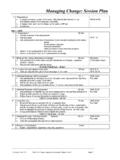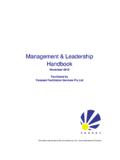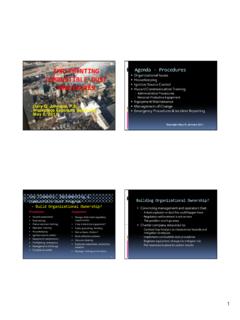Transcription of Core Clinical Processes & Documentation for MRO in
1 October 2007 core Clinical Processes & Documentation FOR MRO IN CONNECTICUTLee Ann Slayton & Lesa Yawn, The Technical Assistance CollaborativeOctober 2007 Objectives Identify required components of assessments to establish medical necessity for rehabilitation option Develop treatment and rehabilitation plans that incorporate client priorities and meet standards for billing Medicaid. Outline key procedures to establish and maintain linkages among various programs and/or agencies involved in the delivering MRO services. Use Documentation templates to ensure their own agencies have Documentation structures that meet MRO requirements. Outline how to use the CASIG as part of the ACT and Community Outline how to use the CASIG as part of the ACT and Community Support treatment planning Processes .
2 Develop internal tracking systems to ensure that all Documentation and coordination requirements are 2007 Medicaid, Medical Necessity & Rehabilitation3 CMS Proposed Rules for Rehabilitation Services* All Rehab Services Incorporated: Physical as well as Ps chiatric4 Psychiatric Clear Emphasis on Restoration/Improvement of Function Requires Person-Centered Planning in Psychiatric Rehab Requires Progress; maintenance of effort not sufficientOctober 2007 CMS Defines Rehabilitation5 Medical or remedial services recommended by a ph sician or other licensed practitioner of the physician or other licensed practitioner of the healing arts, within the scope of his practice under State law, for maximum reduction of physical or mental disability and restoration of a recipient to his best possible functional level.
3 Th ltit l i t d th dti d .. the ultimate goal is to reduce the duration and intensity of medical care to the least intrusive level possible which sustains health. CMS Proposed RegulationsMedical Necessity: CT Definition6 Medically necessary means health care provided to correct or diminish the ad erse effects of a to correct or diminish the adverse effects of a medical condition or mental illness; to assist an individual in attaining or maintaining an optimal level of health; to diagnose a medical condition or mental illness; or to prevent a condition from occurring occurring. October 2007 Key Concepts for Medical Necessity in Rehab7 No service or intervention, by itself, is medically necessary Requires a chain of evidence that includes: Requires a chain of evidence that includes: Eligible client & condition Assessment that documents impact of illness/condition on functioning AND that functioning can be improved/restored Order for services Treatment/rehabilitation plan that outlines covered interventions to meet outcomes with expected duration, frequency, intensity Service delivery in alignment with plan Documentation of service delivery Funder rules are followed (who, what, when, how, etc.)
4 Rehabilitation for Clinicians Medical necessity based on functional criteria, not just diagnosis. Focus is on teaching not providing cueing, reminding, training, overcoming barriers8overcoming barriers Must specifically references a covered service (so residential rehab , not housing; Community Support Team not case management) Clearly rehabilitative, not medical/ Clinical Organized approach to development of new or redevelopment of old competencies Implies that a baseline has been established (can be through assessment) Not clinically focused although Clinical services may play an integral or supportive role in treatment (referenced separately) Symptom reduction is not the focus symptom and disability self-management are Must focus on restoration/improvement of functioning Will replaceTCM for vast majority of clientsOctober 2007 Another Look9 ClinicalRehabUse tools and techniques to guide, Use tools and techniques to address facilitate and provide opportunity for change functional impairment and restore level of functionFocus primarily on internalization to motivate behavioral changesFocus on skill acquisition and mastery,adapting environment.
5 And accessing resourcesNot always transparent and usually the balance of power is with the professional providerAlmost always transparent and is dependent on partnering to yield successful resultsprovidersuccessful resultsMay involve skills: DBT, anger management, always involves skills of one sort or does that mean for Clinicians? REHABILITATION f i d it d b di bilit d 10 focuses on issues caused or impacted by disability and directly related to psychiatric illness Not just beneficial necessary Eventually as defined in State Medicaid Plan; currently defined in DMHAS Service Definitions available on DMHAS websiteOctober 2007 Demonstrating Medical Necessity Assessment documents psychiatric condition and impact on functioning in other words says that condition is something h hb hl11that rehab can help.
6 Order for Services links assessment to client goals and key rehaboutcomes. Rehab Plan addresses areas identified on assessment & summarized on order, and includes steps to restore functioning Rehab Plan prescribes services in amount & duration bl td t f t h ( t l)reasonably expected to foster change (or prevent relapse) Interventions directly relate to Rehab Plan Notes demonstrate progress (or prevention of relapse)Medical Necessity cannot be defined without Matching the following: A defined client need which is clinically assessedAf12 A defined service individualized and structured and delivered specific to the client s need Reflective of best practice and known outcomeAND FOR REHABILITATION: Assessed functional needs Interventions that will restore/improve functioningOctober 2007 Connecting the Dots.
7 13 Client Goals Comprehensive Assessment: Clinical Biopsychosocial, Functional Strengths Documents eligibility Reflects Client wants AND Assessment Incorporates Outcomes of Treatment Specifies services (modalities), itti f Treatment Plan Directly tied to treatment plan Based on evidence and best practice Clearly defined Evaluated with client and independentlyAssessmentinterventions, frequency & duration Prioritizes For Rehab: Focus on functionInterventionsMedical Necessity Discussion When might the following be medically necessary? When are the not?14 When are they not? Parenting skills House cleaning Weight management Social SkillsOctober 2007 Rehab-Focused Assessment15 RehabFocused AssessmentCMS Proposed Rules The rehabilitation plan must be based on a comprehensi e assessment of an indi id al s 16comprehensive assessment of an individual s rehabilitation needs including diagnoses and presence of a functional impairment in daily living.
8 October 2007 This Means That the Assessment Must include the standard diagnostic assessmentMff17 Must include an assessment of functioning that ties the diagnostic issues to the functioning issues. A functional deficit alone is not sufficient. It must be tied back to the diagnostic PidSpecialty PidACT ProviderAssessment: Who Does What?18 ProviderProviderDiagnostic AssessmentXInitial LOCUSXR epeat LOCUSXXOfOrder for RehabXRe-Ordering RehabXXCASIGXXO ctober 2007 Recovery-Oriented Assessment Philosophy Initiates helping relationships Ongoing process 19 Domain based Identifies strengths abilities and past accomplishments interests and aspirations resources and assets unique individual attributesSifif/h Specifies stage of recovery/change Ties Diagnosis to Life FunctioningAssessing Function Outlines how the client s illness is interfering with their f nctioning and their abilit to achie e their 20their functioning and their ability to achieve their best possible functional level.
9 As part of that, outlines functional deficits and functional strengths. Ties the functioning level to the illness AND to the client s recovery goals. IF YOU CAN T DO THIS, then rehab services are not appropriate for this 2007 Functional Assessment Tools & Levels Like Clinical assessment, functional assessment is ongoing B t pa attention to specific ses21ongoing. But pay attention to specific uses: To determine program/payor eligibility To recommend Level of Care CT will use LOCUS for this To aid treatment & rehabilitation planning M t l i l di CASIG (CT ill CASIG) Many tools, including CASIG (CT will use CASIG) To assist in planning intervention sequences Borrow from OT and MRDDLOCUS22 The LOCUS should be administered at initial assessment to help g ide le el of care (ACT ers s assessment to help guide level of care (ACT versus Community Support).)
10 The LOCUS should then be administered every 90 days for clients in ACT and once a year for clients in Community Support. The follow-up LOCUS can be d i i td b ACT t th Lid St ff administered by ACT team or the Licensed Staff supervising Community Support. (More often if indicated) DMHAS will eventually require submission of 2007 LOCUS Scores*23 For ACT or Group Homes or Higher LOCUS scores of 20 or above (Level 4 or above) LOCUS scores of 20 or above (Level 4 or above) For Community Support LOCUS scores of 14 19 (Level 2 or 3) LOCUS Level 4 if no ACT team in community OR client is actively engaged in some community services that would contraindicate ACTCit Rfl/SlfHl Community Referral/Self-Help LOCUS scores of 10-13, Level 1 *Remember that scores are only ONE indicator for level of good rehabilitation assessment answers.
















